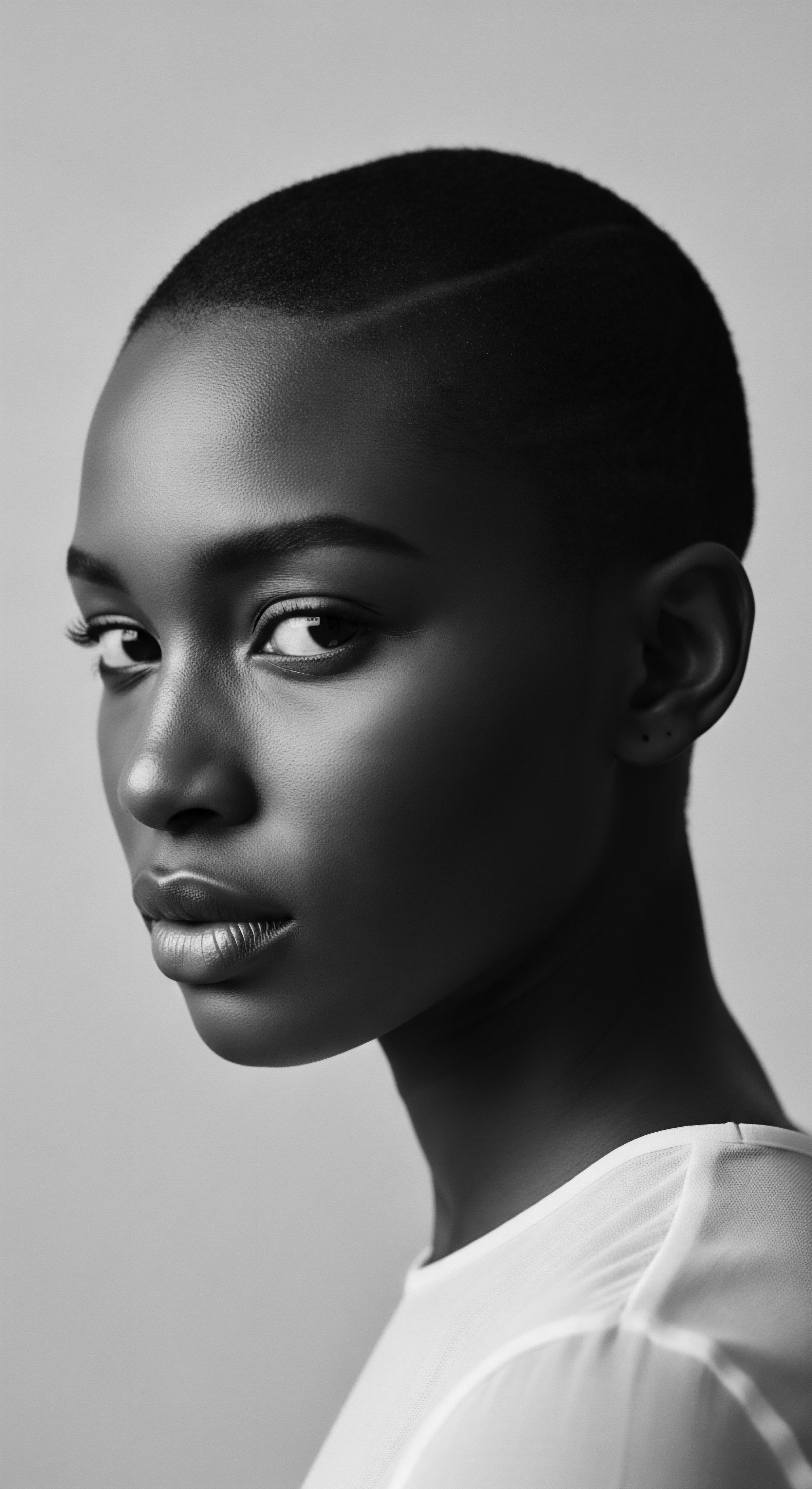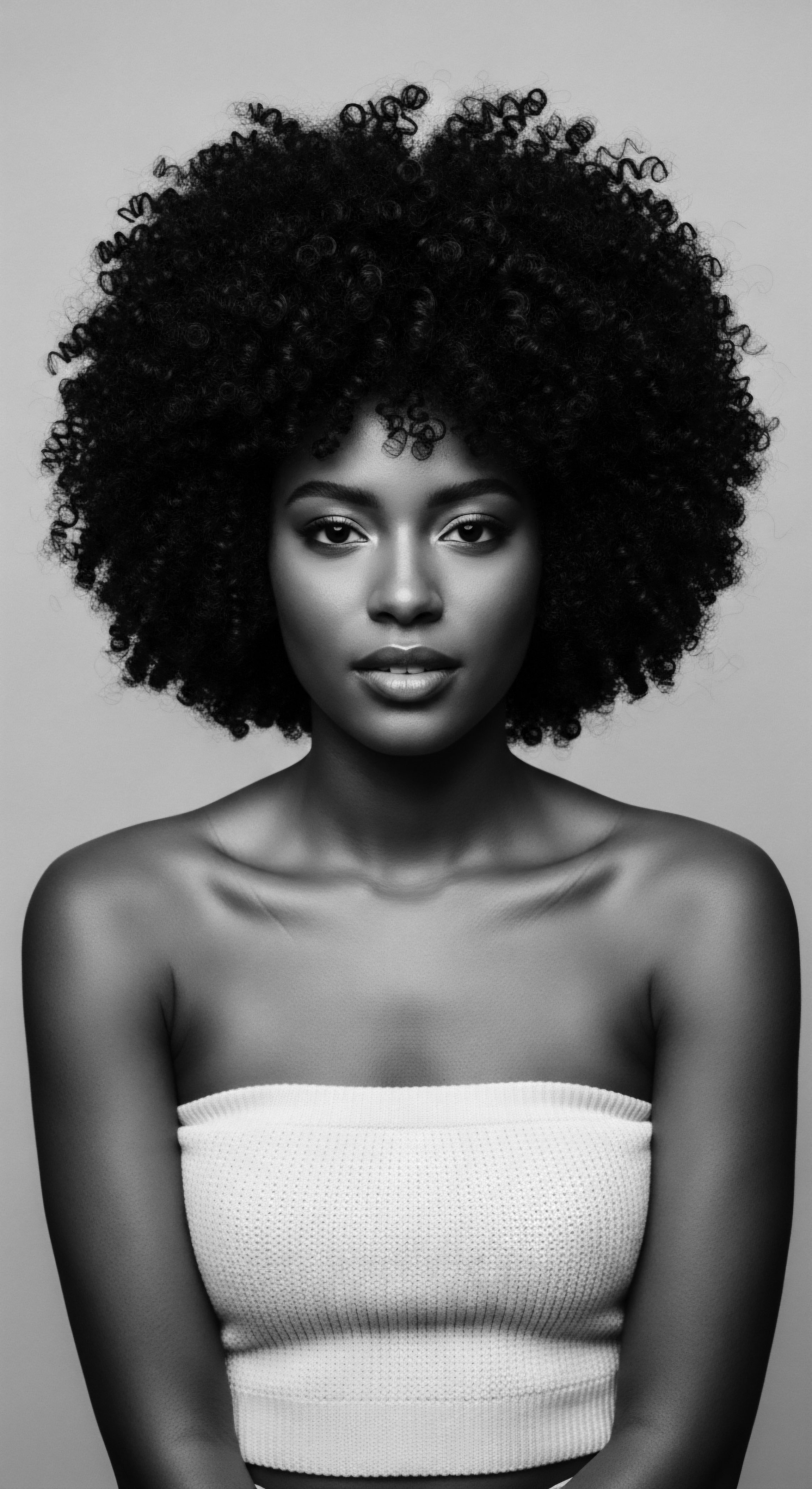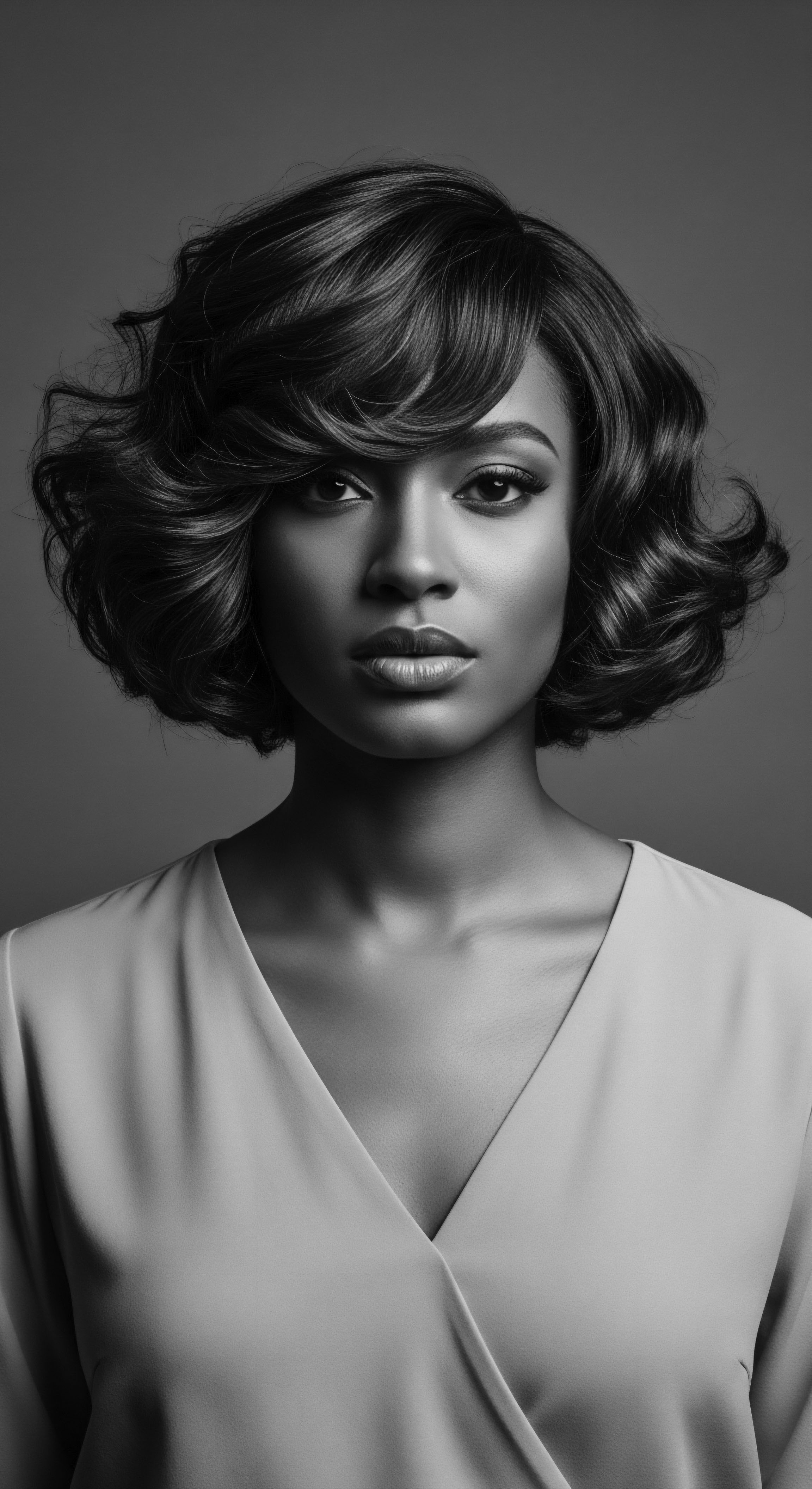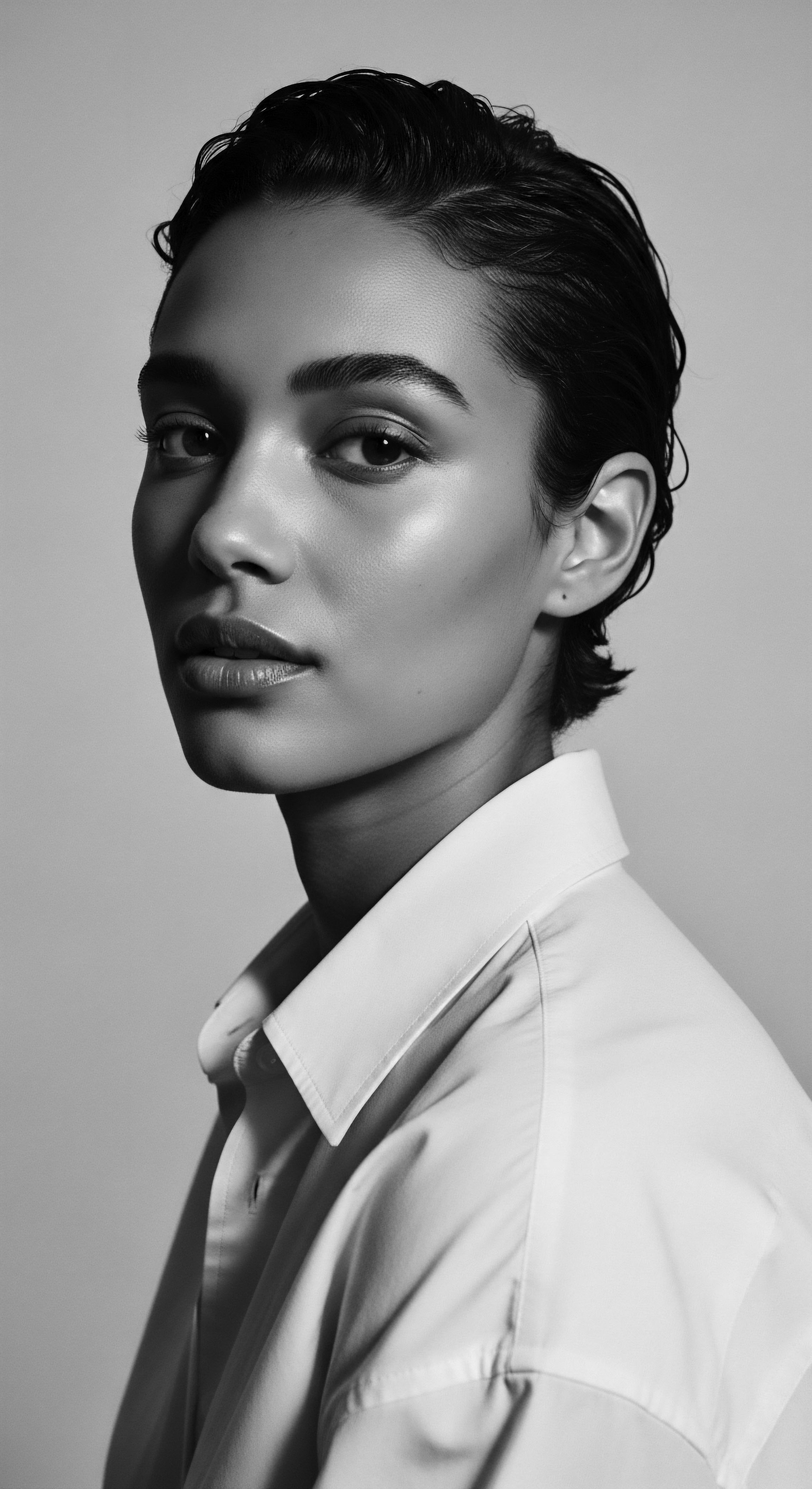
Roots
Across the sweep of human lineage, long before the lexicon of science graced our lips, our ancestors possessed a profound, intuitive understanding of the earth’s bounty and its sympathetic relationship with our very being. This ancestral wisdom, passed through generations like the most treasured heirlooms, whispers of a time when hair — particularly its textured, spiraling forms — was not merely an aesthetic adornment. It served as a living archive, a spiritual antenna, a visible marker of community, status, and identity.
Its protection was not a vanity, but a practice steeped in reverence, a conscious act of preserving one’s connection to lineage and life force. For those who bore the glorious coils and kinks, the very structure of their hair presented a unique set of needs, needs that ancient communities met with the liquid gold of the land ❉ oils.
The distinctive architecture of textured hair, with its elliptical follicle and the inherent twists along its shaft, renders it more susceptible to dryness and mechanical stress compared to its straighter counterparts. Each twist creates a point of vulnerability, a place where the cuticle, the hair’s protective outer layer, can lift and allow moisture to escape. This biological reality, though articulated today through microscopic lenses, was acutely felt and understood by those who lived with these strands, their wisdom woven into daily rituals. The earliest caretakers of textured hair observed that certain plant extracts, rich in lipids, could coat the hair, sealing in precious moisture and providing a soft shield against the elements – sun, wind, and the relentless pull of daily living.

The Sacred Geometry of Hair and Earth’s Balm
The profound interplay between the innate structure of textured hair and the protective properties of natural oils was a truth intuited through generations of lived experience. Consider the way light catches on a tightly coiled strand; its very shape can scatter light, giving it a characteristic sheen, distinct from the linear reflectivity of straighter hair. This visual aspect, combined with its natural inclination towards dryness, made oils an indispensable ally. These were not just conditioners; they were protectors, imbued with a spiritual and communal significance that transcended their mere physical properties.
In many ancient societies, the rituals surrounding hair care were not solitary acts but communal gatherings, often involving women sharing ancestral knowledge. The selection of specific oils was often deeply tied to regional flora and the properties observed over centuries. For instance, the fatty acids present in oils like shea butter, derived from the kernels of the shea tree (Vitellaria paradoxa), provided a thick, emollient barrier.
In arid climates, this barrier helped to prevent water loss from the hair shaft, a constant challenge for textured hair. Other oils, perhaps lighter, offered different benefits, each chosen with discernment.
Ancient communities recognized the unique structural needs of textured hair, intuitively turning to natural oils as vital shields against environmental stress and moisture loss.

Ancestral Pharmacopoeia ❉ Oils and Their Origins
The global reach of textured hair meant that disparate communities across continents, often without direct contact, independently discovered the protective bounty of their local ecosystems. The ingredients they chose for hair care were often multi-purpose, serving medicinal, nutritional, and cosmetic roles within their broader wellness philosophies.
- Shea Butter (Vitellaria paradoxa) ❉ Revered across West Africa, this rich, creamy substance was a staple for skin and hair. Its high concentration of fatty acids and vitamins A and E made it ideal for moisturizing and sealing textured strands. Women often prepared it communally, singing ancient songs as they churned the kernels.
- Moringa Oil (Moringa oleifera) ❉ Sourced from the ‘Miracle Tree’ found in parts of Africa, India, and the Middle East, moringa oil was prized for its light texture and purported nourishing qualities. Its application to hair, particularly in regions like ancient Egypt and Nubia, suggested an awareness of its ability to condition without weighing down coils.
- Castor Oil (Ricinus communis) ❉ Evidence of castor oil use stretches back to ancient Egypt and beyond. Known for its viscosity and ability to promote hair growth and thickness, it served as a robust protective agent for various hair types, including the more robust textured strands that benefited from its coating properties.
- Olive Oil (Olea europaea) ❉ A Mediterranean marvel, olive oil was a pervasive element in ancient Greek, Roman, and Egyptian grooming. Its widespread availability and emollient properties made it a common choice for conditioning and softening hair, helping to manage the natural dryness often seen in textured hair.
The choices made by these communities were not random; they were observations honed over millennia. They understood, without modern scientific vocabulary, the concepts of emollients, occlusives, and humectants simply through the direct experience of what worked to keep hair supple and resistant to breakage. This deep, experiential knowledge formed the bedrock of their hair care regimens, proving that the heritage of textured hair care is as old as humanity itself.
To understand the deep heritage of how ancient communities protected textured hair, we might consider the practices within the Kushite Kingdom, particularly centered around its capital, Meroe. This ancient Nubian civilization, flourishing for centuries south of Egypt, offers compelling evidence of sophisticated hair care that relied heavily on natural oils. Archeological excavations have yielded numerous artifacts related to personal grooming, including combs, hairpins, and cosmetic palettes, alongside preserved hair strands from burials. Studies of these ancient hair samples often show residues of fatty substances, indicative of consistent application of oils or balms.
For example, analyses of hair from ancient Egyptian and Nubian mummies, such as those from sites like Qau el-Kebir and Gebel Adda, frequently reveal traces of animal fats and plant oils (Robins & Eaton-Krauss, 1994). This physical evidence underscores that the application of these substances was not incidental but a deliberate, systematic practice for hair maintenance.
These oils served to lubricate the hair, reducing friction and minimizing breakage during styling and daily wear. For the tightly coiled and often more fragile strands common among these populations, this protective layer was crucial. The oils helped to create a barrier against the harsh desert environment, shielding the hair from drying winds and intense sun.
Beyond protection, the oils contributed to the aesthetic of the hair, giving it a healthy sheen and making it more manageable for the intricate braids and elaborate coiffures often depicted in ancient Kushite art. The very act of oiling was likely integrated into social rituals, transforming a practical necessity into a cultural expression of beauty, health, and community cohesion.
| Oil Source (Region) Shea Butter (West Africa) |
| Traditional Application for Textured Hair Applied as a thick balm for sealing moisture, softening strands, and styling braids. |
| Understood Protective Benefit (Ancient Perception) Keeps hair soft, prevents dryness, makes hair manageable. |
| Corroborated Scientific Benefit (Modern Understanding) High in oleic and stearic acids, forms an occlusive barrier, rich in anti-inflammatory compounds. |
| Oil Source (Region) Moringa Oil (Northeast Africa, India) |
| Traditional Application for Textured Hair Used for light conditioning, scalp health, and general hair vigor. |
| Understood Protective Benefit (Ancient Perception) Nourishes hair, gives a healthy appearance, perhaps aids growth. |
| Corroborated Scientific Benefit (Modern Understanding) Contains monounsaturated fatty acids (oleic acid) and antioxidants; provides light conditioning. |
| Oil Source (Region) Castor Oil (Egypt, Africa, India) |
| Traditional Application for Textured Hair Applied for thickness, strength, and as a styling base for elaborate forms. |
| Understood Protective Benefit (Ancient Perception) Promotes hair fullness, prevents thinning, holds styles in place. |
| Corroborated Scientific Benefit (Modern Understanding) Richest source of ricinoleic acid, which possesses humectant properties and may support scalp health. |
| Oil Source (Region) Olive Oil (Mediterranean) |
| Traditional Application for Textured Hair Used as a general conditioner, to add sheen, and to aid in detangling. |
| Understood Protective Benefit (Ancient Perception) Moisturizes, adds luster, makes hair easier to comb. |
| Corroborated Scientific Benefit (Modern Understanding) Rich in monounsaturated fats and antioxidants; provides emolliency and reduces frizz. |
| Oil Source (Region) The legacy of these ancient oil applications underscores a deep, inherited knowledge of textured hair needs, validated by contemporary science. |

Ritual
The use of oils in ancient communities was not a haphazard act but a deliberate component of ritualized hair care, deeply tied to styling and cultural expression. These practices formed a tender thread, weaving through daily life, preparing textured strands for the intricate styles that often conveyed social standing, marital status, or tribal affiliation. The transformation of raw materials into a protective balm or a glossy finish was an art, a science, and a communal experience, all intertwined with the very heritage of human adornment.
For textured hair, styling frequently began with a foundational application of oils. This wasn’t simply about adding shine; it was about preparing the hair for manipulation. Coils and kinks, if dry, are prone to snapping under tension.
Oils provided lubrication, allowing fingers or combs to glide more smoothly, thus reducing breakage during braiding, twisting, or coiling. This pre-treatment was a silent acknowledgment of the hair’s delicate yet resilient nature, a practice honed over countless generations.

How Did Ancient Hair Oils Influence Styling Techniques?
The interaction between oils and styling techniques reveals a profound understanding of hair mechanics. Many ancient styles, such as cornrows, bantu knots, and various forms of braids, served as protective measures, tucking away delicate ends and minimizing exposure to environmental damage. Oils were instrumental in achieving and maintaining these styles. A well-oiled strand was more pliable, less likely to frizz, and held its shape longer, extending the life of protective styles that could take hours, if not days, to create.
Consider the meticulous art of plaiting in ancient West African societies. Before strands were painstakingly divided and interwoven, they would often be coated with a blend of natural oils and sometimes clay or ochre, which served both functional and symbolic purposes. These coatings added weight and slip, making the hair easier to section and braid tightly without causing undue tension or breakage at the roots.
The oils also helped to set the style, giving it longevity and a polished appearance. This preparation was not a luxury; it was a fundamental step in ensuring the health and durability of the elaborate coiffures, which were, in essence, wearable sculptures of cultural identity.
Oils were fundamental to ancient styling, providing lubrication for manipulation, reducing breakage, and setting intricate coiffures that spoke volumes about cultural identity.

Tools of Transformation and Their Oily Companions
The tools used in ancient hair care were often simple yet highly effective, their efficacy amplified by the judicious use of oils. Before the advent of modern detanglers, the innate slip provided by natural oils was a primary aid in untangling dense, textured hair.
- Wide-Toothed Combs ❉ Carved from wood, bone, or horn, these combs were designed to gently separate tangles. Applying oil prior to combing minimized friction, allowing the comb to move through the hair with less resistance and reducing mechanical damage.
- Hairpins and Fasteners ❉ Decorative and functional, these were used to secure elaborate up-dos and twists. Oils helped maintain the integrity of these styles, preventing stray strands from escaping and keeping the hair moisturized beneath the pins.
- Styling Sticks and Bodkins ❉ In some cultures, smooth sticks or bodkins were used to create precise parts or define coils. Oiling the hair before using these tools ensured crisp lines and enhanced the definition of the texture.
These tools, though varied in form, shared a common reliance on oils to facilitate their purpose. The synergy between the tool, the hand that wielded it, and the oil that prepared the strand was a testament to ancestral ingenuity. It speaks to a heritage where care was not segmented but flowed organically from preparation to adornment, each step contributing to the vitality and beauty of textured hair.
| Ancient Tool Type Carved Bone/Wood Combs |
| Historical Usage with Oils Used for detangling oiled hair, aiding sectioning for braids and twists. |
| Modern Parallel / Successor Wide-tooth detangling combs (plastic/wood). |
| Continued Relevance of Oils Oils remain crucial for slip and damage prevention during detangling. |
| Ancient Tool Type Simple Hairpins / Fasteners |
| Historical Usage with Oils Securing oiled braids, twists, and buns; maintaining style integrity. |
| Modern Parallel / Successor Bobby pins, hair ties, decorative clips. |
| Continued Relevance of Oils Oils still help maintain style hold, reduce frizz, and keep secured hair moisturized. |
| Ancient Tool Type Styling Sticks / Bodkins |
| Historical Usage with Oils Creating clean parts and defining coil patterns in prepared hair. |
| Modern Parallel / Successor Rat-tail combs, styling brushes, finger coiling. |
| Continued Relevance of Oils Oils aid in precise parting, enhancing curl definition, and smoothing the cuticle during styling. |
| Ancient Tool Type Heated Stones / Rods |
| Historical Usage with Oils Used cautiously on oiled hair for temporary straightening or curl setting. |
| Modern Parallel / Successor Flat irons, curling wands (electric). |
| Continued Relevance of Oils Heat protectant oils are essential to shield hair from thermal damage, a modern extension of ancient caution. |
| Ancient Tool Type The evolution of styling tools reveals an ongoing reliance on oils to enhance manipulation, protect against damage, and preserve the integrity of textured hair coiffures. |
The narratives of transformation, from raw oil to lustrous style, echo through millennia. These are not merely stories of fashion but of resilience, identity, and the profound connection between cultural heritage and personal adornment. The ritualistic application of oils was a testament to the high regard held for textured hair, a practice that ensured its health while enabling its expression as a powerful visual language.

Relay
The heritage of ancient oil use for textured hair is not a static relic of the past; it is a living current, flowing through generations, adapting yet retaining its core wisdom. This relay of knowledge, from elder to youth, from ancestral practice to contemporary understanding, bridges the chasm between elemental biology and sophisticated cultural meaning. We find echoes of ancient ingenuity not just in historical texts, but in the enduring efficacy of these time-honored remedies, now often validated by the meticulous gaze of modern science.
The protective qualities of oils, once understood through observation and trial, are now explained by chemistry. The rich lipid profiles of shea butter, the unique ricinoleic acid in castor oil, and the antioxidant power of olive oil are not new discoveries, but rather scientific confirmations of truths held for centuries. This symbiotic relationship between ancestral wisdom and contemporary research creates a more complete tapestry of understanding, enriching our appreciation for the historical practices concerning textured hair.

How Do Ancient Oil Practices Inform Modern Hair Science?
The molecular structure of oils, with their long chains of fatty acids, allows them to penetrate the outer cuticle layers of the hair shaft or to sit on the surface, forming a protective film. For textured hair, which has a naturally raised cuticle and often lower natural sebum production, this external lipid application is especially beneficial. Ancient communities, through their consistent application of oils, effectively mitigated transepidermal water loss from the scalp and reduced moisture evaporation from the hair strand itself.
Modern trichology recognizes that oils can ❉
- Reduce Hygral Fatigue ❉ This refers to the repeated swelling and shrinking of hair as it absorbs and releases water, which can lead to damage. Oils, especially those that can penetrate the hair shaft, can reduce the amount of water absorbed, thereby mitigating this fatigue.
- Improve Elasticity and Suppleness ❉ By conditioning the hair, oils make it more flexible and less prone to breaking under tension, a common issue for textured hair during styling and manipulation.
- Protect Against Environmental Stressors ❉ Just as ancient sun and wind dried out hair, modern environmental factors like pollution and dry indoor air continue to pose threats. Oils act as a physical barrier.
The persistent use of certain oils across diverse ancient cultures speaks to their demonstrable benefits. For instance, the enduring popularity of Coconut Oil in tropical regions like parts of India and Southeast Asia for hair care is not accidental. Studies have shown that coconut oil, with its unique lauric acid structure, can penetrate the hair shaft more effectively than many other oils, leading to reduced protein loss (Rele & Mohile, 2003).
This scientific validation illuminates why this oil held such high regard in ancestral hair care regimens, proving its protective efficacy beyond anecdotal evidence. This deeper insight allows us to connect the dots between ancient practice and the elemental biology of the strand.
Ancient wisdom regarding hair oils gains scientific validation, revealing how traditional practices inherently addressed the unique biological needs of textured hair.

Beyond the Physical ❉ Oil as a Symbol of Resilience and Heritage
The application of oils for textured hair transcended mere physical protection; it was an act imbued with cultural meaning, a language spoken through touch and tradition. For many Black and mixed-race experiences, the hair journey has been fraught with challenges, from the historical erasure of traditional practices to the imposition of Eurocentric beauty standards. Yet, the persistent use of oils, passed down through families, represents an unbroken chain of heritage, a quiet act of resistance, and a celebration of one’s intrinsic beauty.
Consider the stories whispered during hair-braiding sessions, often accompanied by the gentle aroma of warmed oils. These moments were, and remain, sites of intergenerational knowledge transfer. They were where children learned not just how to oil their scalp or plait their hair, but also about self-acceptance, the strength of their lineage, and the beauty inherent in their coils. The oil, in this context, becomes a tangible link to ancestors, a liquid echo of their care and resilience.
The continuity of these practices, from ancient African kingdoms to the contemporary diaspora, speaks to their deep cultural roots. Despite displacement and disconnection, the memory of these oils, their uses, and their significance persisted. They became a touchstone, a way to maintain cultural memory and identity when so much else was under assault. This makes the heritage of oil use for textured hair not merely a historical footnote, but a powerful ongoing narrative of self-preservation and cultural affirmation.
| Aspect Purpose |
| Ancient Community Context Primary physical protection against environment; spiritual/communal ritual. |
| Contemporary Heritage Connection Physical protection; identity affirmation; connection to ancestral practices. |
| Aspect Selection of Oils |
| Ancient Community Context Based on regional availability, observed efficacy, traditional knowledge. |
| Contemporary Heritage Connection Informed by ancestral knowledge, scientific validation, personal needs. |
| Aspect Application Method |
| Ancient Community Context Often communal, deliberate, part of daily/weekly grooming routines. |
| Contemporary Heritage Connection Can be personal or communal; part of diverse care regimens. |
| Aspect Cultural Role |
| Ancient Community Context Marker of status, beauty, tribal affiliation, spiritual readiness. |
| Contemporary Heritage Connection Symbol of self-care, cultural pride, resilience, intergenerational bond. |
| Aspect The enduring role of oils in textured hair care illustrates a continuity of practice driven by both physical necessity and profound cultural heritage. |

Reflection
The exploration of how ancient communities used oils to protect textured hair leads us back to the very soul of a strand, revealing a living, breathing archive of wisdom. It is a testament to the profound connection between humanity and the earth, a bond that transcended time and geography. The ancestral hands that pressed seeds for their precious oils, those that meticulously applied them to coiled strands, laid a foundation of care that continues to sustain us.
This enduring heritage reminds us that true wellness, particularly for our hair, is often found not in fleeting trends, but in the echoes of practices that have served for millennia. Our textured hair, protected and adorned by the gifts of the earth, stands as a vibrant beacon of history, resilience, and identity, a sacred legacy we are privileged to carry forward.

References
- Robins, Gay, and Ann Rosalie Eaton-Krauss. 1994. Portraiture in Ancient Egypt. Yale University Press.
- Rele, Jayashree S. and R. B. Mohile. 2003. “Effect of Mineral Oil, Sunflower Oil, and Coconut Oil on Prevention of Hair Damage.” Journal of Cosmetic Science 54, no. 2 ❉ 175-192.
- Gopalan, C. B. V. Rama Sastri, and S. C. Balasubramanian. 1989. Nutritive Value of Indian Foods. National Institute of Nutrition.
- Dudley, Mary D. 2011. Hair Story ❉ Untangling the Roots of Black Hair in America. St. Martin’s Press.
- Thompson, Kimberly A. 2006. Black Women and Beauty ❉ Recreating an Ancient Aesthetic. Palgrave Macmillan.
